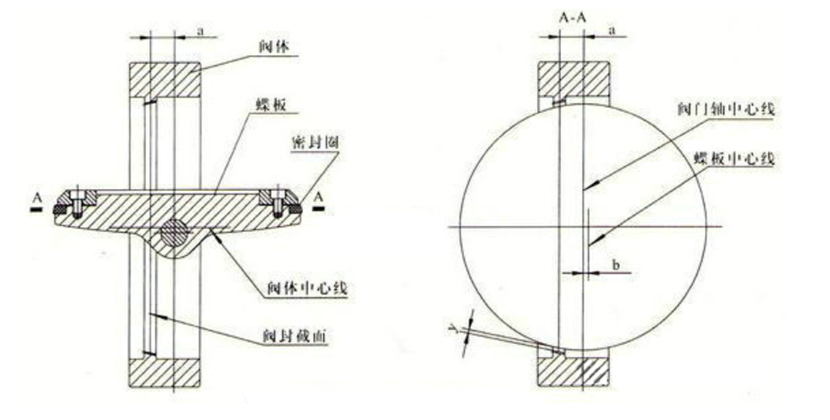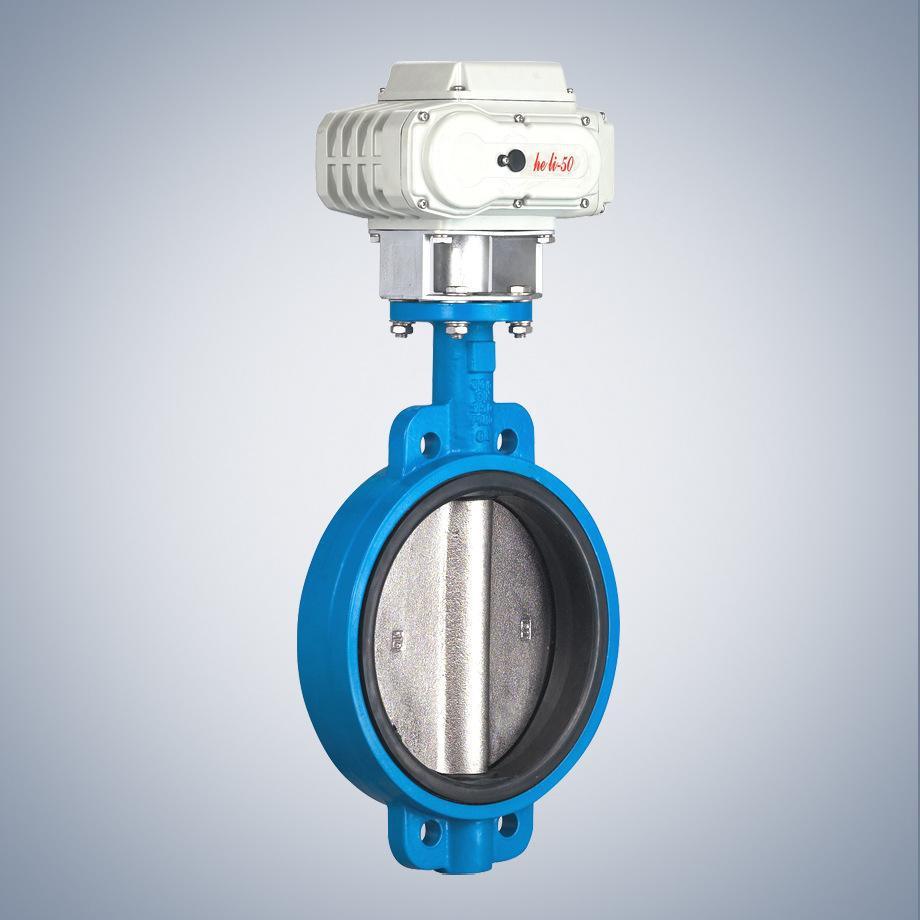Electric Flanged Butterfly Valve
Tianjin Kaiji can provide a series of butterfly valves and accessories, actuators for pipelines of mineral processing plant and coal washing plant.
Brief Introduction
The butterfly valve is a common type of fluid control valve, primarily composed of a valve body, stem, disc, and sealing ring. The valve body has a cylindrical shape with a short axial length and contains a built-in disc. It is suitable for controlling the flow of various fluids, including air, water, steam, various corrosive media, slurries, oils, liquid metals, and radioactive media. On pipelines, it primarily serves functions of shut-off and throttling. The butterfly valve operates by rotating its disc approximately 90° to open, close, or regulate the flow of media. When fully open, it offers minimal flow resistance.

Open and Close Status of Butterfly Valve
Features
- The butterfly valve features a simple structure, compact size, lightweight design, and low material consumption. It has a small installation footprint, quick opening and closing capabilities with a 90° rotation, and requires low operating torque. It is suitable for cutting off, connecting, and regulating media flow in pipelines, with excellent fluid control characteristics and reliable sealing performance.
- The butterfly valve can handle slurry transport with minimal fluid retention at the pipeline interface. It provides effective sealing under low pressure and has good regulation performance.
- The streamlined design of the disc minimizes fluid resistance, making it an energy-efficient product.
- The valve stem is of a through-shaft design and has undergone quenching and tempering treatment, providing excellent mechanical properties, corrosion resistance, and wear resistance. During operation, the valve stem rotates without moving up or down, which reduces wear on the stem packing and ensures reliable sealing. The stem is secured to the disc with a taper pin, and the outer end is designed to prevent blowout, protecting against sudden ejection in case of stem-disc connection failure.
- Connection types include flange, wafer, butt-weld, and lug wafer connections. Available actuation methods include manual, worm gear, electric, pneumatic, hydraulic, and electro-hydraulic actuators, allowing for remote control and automation.
Based on their structure and application, butterfly valves can be classified into the following types:
1. Centerline Butterfly Valve: This is the most common type of butterfly valve, featuring a symmetric, non-offset design where sealing pressure is generated by the elastic force created from the interference fit between the disc and the liner. When closing, the sealing contact trajectory begins from both ends of the disc and gradually extends along both sides to form a continuous circular seal. The process is reversed when opening. This continuous sealing motion provides a self-cleaning effect between the disc and the liner, making it suitable for media of various viscosities, semi-fluid media, and particulate media. Common applications include pipelines on ships for controlling seawater, refined oil, crude oil, and air, performing shut-off and flow regulation. It is simple in structure, cost-effective, and widely used in general industrial applications.
Typical models: D71X-16, D371X-16, D41X-16, D341X-16.
2. Double Eccentric Butterfly Valve: In this design, the disc rotation center (i.e., the valve shaft center) is offset by distance A from the disc sealing surface and by distance B from the valve body center. The structure is characterized by an axis that is neither fully aligned with the disc center nor the body center. This double-offset design enables the disc to quickly disengage from the seat during opening, greatly reducing unnecessary excessive compression and scraping between the disc and seat. This results in lower opening resistance, reduced wear, and extended seat life. The reduction in scraping also allows double eccentric butterfly valves to use metal seats, enhancing their performance in high-temperature environments. Double eccentric butterfly valves are available with both soft and hard seal structures, making them suitable for pipelines in industries such as oil, metallurgy, chemicals, food, pharmaceuticals, hydropower, marine municipal engineering, and water supply and drainage systems. They can be used for regulating and cutting off flow in various corrosive and non-corrosive gas, liquid, semi-fluid, and solid powder pipelines and containers.
Typical models: D342X-16, D942X-16.

Double Eccentric Butterfly Valve
3. Triple Eccentric Butterfly Valve: The triple eccentric butterfly valve is an enhanced version of the double eccentric design. It incorporates three offsets: the distance "a" between the disc rotation center and the sealing surface of the valve body, the distance "b" between the disc rotation center and the body’s central axis, and the angle "β" between the inclined conical sealing surface center and the valve body’s central axis. The triple eccentric metal-sealed butterfly valve series is a long-life, energy-efficient type, designed with a three-dimensional eccentricity principle. The valve seat uses a multi-layered structure compatible with both hard and soft seals or an all-metal sealing structure. It supports bidirectional flow installation, making it a high-performance valve suitable for high-temperature and high-pressure environments.
Triple eccentric butterfly valves are widely applied in pipelines for metallurgy, steel, power, oil, chemical, heating, air, gas, combustible gases, municipal water supply, and drainage systems. They can handle both corrosive and non-corrosive media, providing shut-off or connection for pipeline media and also regulating flow as needed.
Typical models: D373H-16, D373W-16, D343H-16, D343W-16.

Triple Eccentric Butterfly Valve
Normal Models of Butterfly Valve
Butterfly valves come in a wide variety of models and specifications, commonly including the following types:
- Ventilation Butterfly Valve Models: D341H, D341W
- Triple Eccentric Wafer-Type Hard-Sealed Butterfly Valve Models: D73H, D373H, D673H, D973H
- Centerline Flange Butterfly Valve Models: D41X, D341X, D641X, D941X
- Centerline Wafer Butterfly Valve Models: D71X, D371X, D671X, D971X
- Double Eccentric Butterfly Valve Models: D342X, D372X, D942X
- Triple Eccentric Welded Hard-Sealed Butterfly Valve Models: D63H, D363H, D663H, D963H
- Worm-Gear Flange-Type Soft-Sealed Butterfly Valve Models: D343F
- Lined Fluorine Butterfly Valve Models: D341F4
- Signal Butterfly Valve Model: XD371X
- Telescopic Butterfly Valve Models: SD343H, SD341X
Each model of butterfly valve is tailored to specific applications and has unique advantages. Selection should be based on factors such as the specific pipeline system, characteristics of the medium, pressure, and temperature conditions.
Butterfly Valve Model Code Explanation
Butterfly valve models follow a structured naming convention, as illustrated by the example D343H-10C:
- ① D – Butterfly valve designation: "D" indicates a butterfly valve.
- ② 3 – Transmission type code:
- Omitted for manual operation
- "3" indicates worm gear
- "6" indicates pneumatic
- "7" indicates hydraulic
- "9" indicates electric
- ③ 4 – Connection type code:
- "4" for flanged
- "6" for welded
- "7" for wafer
- ④ 3 – Structural type code:
- "1" for centerline
- "2" for double eccentric
- "3" for triple eccentric
- "4" for variable eccentric
- "5" for single eccentric
- ⑤ H – Seal material code:
- "H" for stainless steel
- "X" for rubber
- "F" for PTFE (polytetrafluoroethylene)
- "FX" for composite rubber
- "M" for Monel alloy
- "Y" for hard alloy
- "W" for directly machined valve body
- ⑥ 10 – Pressure rating code:
- "10" = PN1.0 MPa
- "16" = PN1.6 MPa
- "25" = PN2.5 MPa
- "40" = PN4.0 MPa
(PN represents the domestic pressure rating, MPa is the pressure unit.) - Class ratings (for American standards) include:
- Class150 LB = 1.6 MPa
- Class300 LB = 2.5–4.0 MPa
(LB is the American pound rating unit)
- ⑦ C – Body material code:
- "C" for cast steel
- "P" for 304 stainless steel
- "R" for 316 stainless steel
- "AL" for special alloy steel
- "Z" for cast iron
- "Q" for ductile iron
- "N" for nylon
Additional Butterfly Valve Codes:
- BD – Insulating butterfly valve
- SD – Telescopic butterfly valve
- TLD – Desulfurization butterfly valve
- DH – Check butterfly valve
- DKS – Quick-action butterfly valve
- FDBD – Square louver butterfly valve
This coding system helps identify specific features for each butterfly valve, supporting accurate selection based on application needs, medium type, pressure, temperature, and pipeline specifications.
Butterfly Valve Connection Types and Characteristics
1. Wafer-Type Butterfly Valve
The disc is positioned along the pipeline diameter, keeping the valve fully open. This design is simple, compact, and lightweight. Wafer-type butterfly valves come in two sealing types: elastic and metal seals. For elastic seals, the sealing ring can be embedded in the valve body or attached around the disc's edge.

Electric Wafer Butterfly Valve

Manual Long Rod Wafer Butterfly Valve
2. Flanged Butterfly Valve
With a vertical plate structure, this type of butterfly valve uses an integral metal hard seal. Its sealing ring, made from a combination of flexible graphite and stainless steel plates, is installed on the valve body, with the disc's sealing surface overlayed with stainless steel. For soft-seal valves, the sealing ring is made from nitrile rubber and is installed on the disc.

Electric Long Rod Flanged Butterfly Valve

Electric Long Rod Flanged Butterfly Valve

Hydraulic Flange Butterfly Valve

Hydraulic Flange Butterfly Valve
3. Lug-Type Butterfly Valve
(Description missing, but lug-type butterfly valves typically have threaded inserts allowing the valve to be bolted to a system, providing support for downstream disconnection.)

Pneumatic Lug Type Butterfly Valve
4. Welded Butterfly Valve
This non-sealed type of butterfly valve is suited for pipelines in building materials, metallurgy, mining, and power industries. It is typically used where the medium temperature is ≤300℃ and the nominal pressure is 0.1 MPa, mainly for connecting, opening/closing, or regulating media flow.

Manual Welded Butterfly Valve
Selection Principles for Butterfly Valves
1. Pressure Loss Consideration
Butterfly valves have higher pressure loss than gate and ball valves, making them suitable for systems where pressure loss is not a strict concern.
2. Flow Regulation
Butterfly valves can be used for flow regulation, making them ideal for pipelines requiring adjustable flow rates.
3. Short Structural Length and Large Diameters
With a shorter structural length and the ability to handle large diameters (e.g., DN≥1000), butterfly valves are preferred where space is limited or for large-diameter applications.
4. Quick Opening/Closing
Since butterfly valves require only a 90° rotation to open or close, they are ideal for applications requiring fast operation.
5. Zero Leakage and Corrosive Media Compatibility
For systems requiring zero leakage and operating at -10 to 150°C with freshwater, wastewater, seawater, brine, steam, natural gas, food, pharmaceuticals, oils, or corrosive media, a centerline butterfly valve is recommended.
6. Bi-directional Flow in Ventilation and Dust Removal
Soft-seal eccentric butterfly valves are ideal for ventilation and dust removal pipelines in gas, water, and other media applications in metallurgy, light industry, power, and petrochemical systems.
7. Metal Sealing for High-Performance Applications
Metal-to-metal sealed triple eccentric butterfly valves are a good alternative to gate and globe valves, especially for large PSA gas separation control applications. They are also widely used in petroleum, petrochemical, chemical, metallurgy, and power industries.
8. Material Compatibility for Different Conditions
Butterfly valves can be manufactured in various material combinations to meet specific requirements for pressure, temperature, media, and operating conditions.

